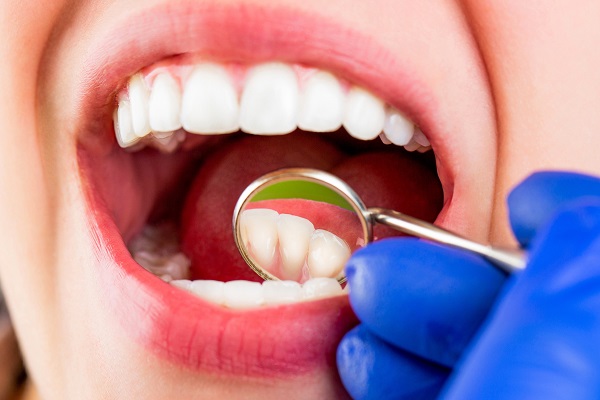Which Dental Restorations a Dentist Might Recommend

Dental restorations offer ways to preserve your teeth and take care of your oral health even when signs of decay begin to occur. A problem might start out as a very small cavity, but if you have not kept up with regular dental appointments and did not notice any pain, it is possible you may need additional work. Learn more about how restorations can help you take care of your teeth and maintain the shape of your mouth.
Common dental restorations
Restorations come in a variety of forms, from a basic filling to implanting a crown. A professional can help you determine which choice is appropriate for your situation based on a variety of factors. The majority of general dentists can handle these types of treatments should you need to have repair work done on your smile.
Fillings for cavities
Fillings are the most basic and common type of dental restoration, and something most dentists perform on a daily basis. Before attempting to fill a tooth, the area where the filling takes place is numbed so the patient feels no pain. The tooth is then filled with composite materials such as resin or tooth-colored plastic, or less commonly, silver or amalgams. Once filled, cavities are no longer as noticeable and any prior tooth pain should cease.
A root canal to preserve teeth
A root canal may be necessary if you have a deep cavity that is too close to the root or there is an infection. A root canal allows you to maintain your current smile without pulling the tooth. First, the dentist ensures that any trace of the infected pulp and root is gone. Then, the tooth is cleaned and filled. Many times a crown is necessary to cover up the filling, help hold the tooth in place, or both. Your dentist may place a temporary crown until one that is custom-fitted can be put on.
Implants to avoid gaps
If you had to have an infected tooth extracted or lost one to an accident and now have a gap in your smile, you may be a candidate for dental implants. Implants can ensure your smile looks intact even after removing a tooth that is broken, infected, or no longer worth saving. An implant procedure takes a few visits. If bone grafting needs to be done, this is usually performed when the infected tooth is extracted. After healing, the implant is inserted into the jaw. A second visit to place the abutment might be necessary unless the dentist decides to do both the implant and abutment together. Finally, a tooth-shaped crown is attached to the abutment, providing you with a complete smile.
Crowns or veneers for chipped or cracked teeth
If chronic decay or a sudden injury causes a tooth to chip, crack, or break, it may still be salvageable. In fact, as long as the root is still healthy and enough tooth material remains intact, a dentist may be able to repair the damage with a dental crown or veneer. These tooth coverings are similar in many ways.
Veneers are thin porcelain tooth coverings that are mounted to the front of a damaged or discolored tooth. This treatment is typically reserved for teeth in the front of the mouth and often results in a beautiful yet very realistic finished product. The outer layer of tooth enamel is removed and the veneer is cemented in place, giving the tooth a more even shape and size while also whitening a patient's smile.
Crowns are also tooth coverings, typically made from porcelain, that are used to repair significant damage to a tooth. Rather than removing just the outer enamel layer, a dentist will need to remove much of the tooth material for this procedure, leaving only enough to support a new tooth cap or crown. These tend to withstand more force than veneers and are often used on teeth toward the back of the mouth. They can also be reinforced with metal when necessary to further improve durability.
Conclusion
Having dental restorations done can preserve your oral health, keep your smile looking beautiful, and allow you to maintain self-confidence. If your dentist suggests any of these procedures, there is likely a good reason behind it. Waiting too long can lead to more damage and other unwanted side effects. Take care of your oral health and get the necessary work done as soon as possible.
Request an appointment here: https://www.everest-dental.com or call Everest Dental at (407) 588-4388 for an appointment in our Oviedo office.
Check out what others are saying about our dental services on Yelp: Dental Restorations in Oviedo, FL.
Related Posts
People who are diligent with oral hygiene may still experience tooth decay or damage that requires dental restorations. Even what may appear to be minor damage should be addressed and repaired by a dentist. Not treating chipped, cracked, or missing teeth can cause serious oral health problems that may otherwise be prevented with simple dental…
Any dental work that is done to repair missing or damaged teeth are types of dental restorations, which can include anything from minor fillings to full implants. How long these restorations take depends entirely on what kind of work is necessary. Some procedures can be performed in a single short appointment, while others might be…
Unlike general dentistry, which focuses on routine examinations and treatment, restorative dentistry is a specialization focusing on the repair or replacement of damaged or missing teeth. Bruxism is a fairly common condition that causes the clenching and grinding of teeth. While no single cause exists for bruxism, the results of teeth grinding are well documented.…
While it is possible to create a beautiful, uniform smile through a smile makeover, the treatment options and results vary according to each patient. Achieving an attractive result requires adhering to the treatment guidelines of the dentist as well as following aftercare recommendations. Not sticking to a dentist's rules and suggestions about a made-over smile…
